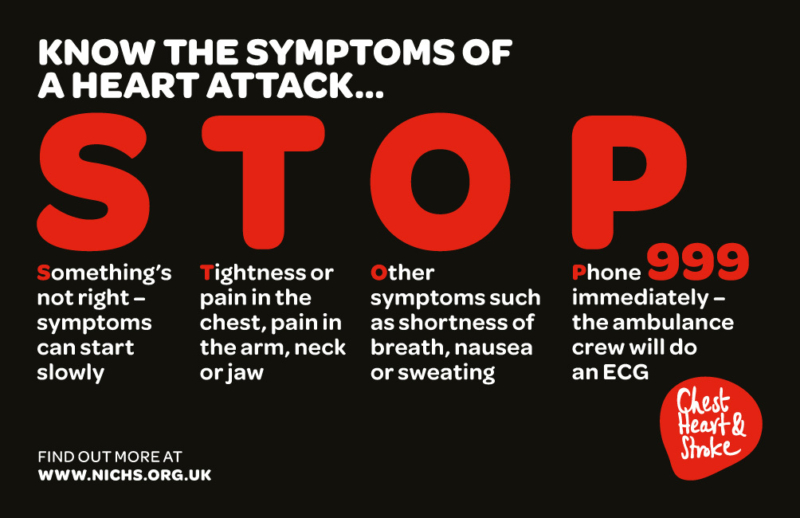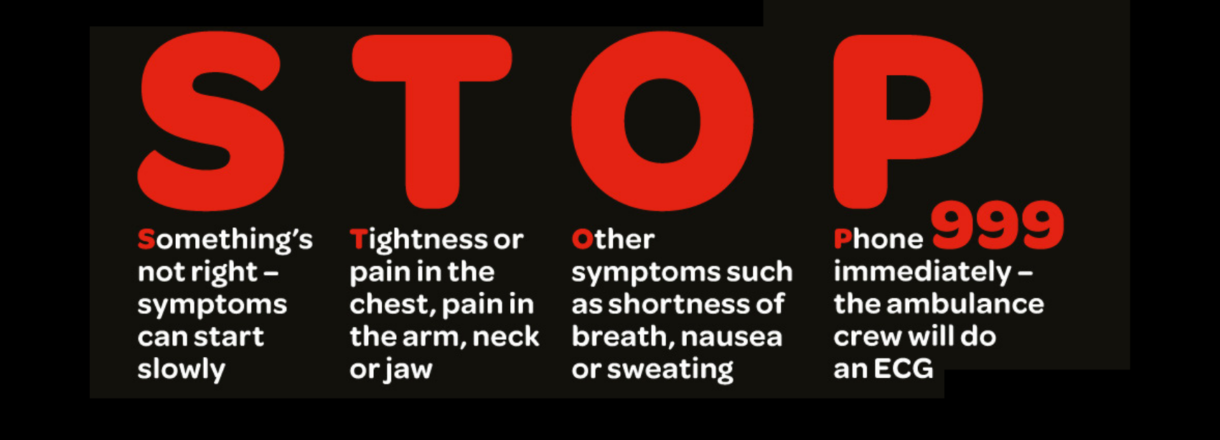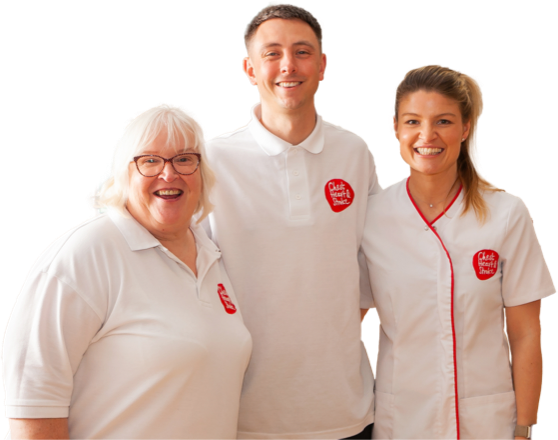STOP - Do you know the signs of a Heart Attack?
A heart attack, also known as myocardial infarction, occurs when an artery becomes blocked.
The symptoms of a heart attack vary from person to person but may be characterised by the acronym STOP.
STOP is an acronym for:
S – Something’s not right – symptoms can start slowly
T – Tightness or pain in the chest, pain in the arm, neck or jaw
O – Other symptoms such as shortness of breath, nausea or sweating
P – Phone 999 immediately – the ambulance crew will do an ECG.
The last letter of STOP is very important – phone 999 immediately. There’s no time to waste when chest pain strikes. Every minute that passes can mean the difference between life and death. Our advice is to call 999 rather than driving the patient to hospital, because the ambulance crew can provide treatment at the scene.

-
Coronary heart disease is one of the leading causes of heart attack. It causes a build–up of fatty deposits (plaque) on the walls of the coronary arteries, which narrows them. These fatty deposits can then rupture and trigger the formation of a blood clot.
A blockage may also result from a spasm or sudden narrowing of a coronary artery. As a result, the heart muscle is starved of oxygen and may be permanently damaged.
-
A heart attack is usually confirmed with heart tests such as an electrocardiogram (ECG) and blood tests. The ECG may be done by the ambulance crew. Treatments to try to restore blood flow to the heart are started as soon as possible.
Initial treatment will include pain relief, oxygen and a combination of medications to thin the blood, widen the blood vessels or slow down the heartbeat.
During a hospital stay, ECGs and blood tests are carried out. Other tests may also be conducted to assess how well the heart is pumping, whether blood flow has been restored and to help decide on the best form of treatment. Click here to find out more information on the types of tests which may be carried out.
Treatment
Medications – After a heart attack, you may need to take a variety of medicines. The aim of administering medication during a heart attack, and just after, is to restore blood flow, save heart tissue and prevent complications. The purpose of subsequent medication is to promote healing of your heart and prevent another heart attack.
Primary Percutaneous Coronary Intervention (PPCI) – This procedure improves blood flow to the heart by using a special balloon to open a blocked artery from the inside. Often a special expandable metal tube (stent) is inserted and left in place to keep the artery open.
PPCI treatment is now available 24/7 across Northern Ireland. When the ambulance crew arrives, they will carry out an ECG on the patient which they forward to the specialist nurse teams at the RVH or Altnagelvin, which are Northern Ireland’s Heart Attack Centres (HACs). This highly specialist triage team then decide if the type of heart attack the patient is experiencing needs PPCI at one of the HACs or if they can be taken to their local A&E. If they are suitable for PPCI, the ambulance crew will take the patient directly to the Cath Lab for treatment, bypassing A&E. Their chance of survival are increased and their chances of reoccurrence are reduced. This is why it is important to call 999 immediately – the sooner this process starts, the better chance the patient has of a good recovery.
Coronary artery bypass graft (CABG) – Increasingly, blockages are being opened up with PCI but there are still cases where surgery is needed. In CABG, healthy arteries or veins taken from other areas in the body are used to bypass narrowed coronary arteries.
-
Recovery after a heart attack will start slowly. For the first few days you will need bed rest but gradually you will become more active, based on advice from your doctor. Structured cardiac rehabilitation programmes start in hospital. Cardiac rehabilitation is a programme to help people manage their heart condition and improve their health. Cardiac rehabilitation has two parts:
Exercise training – Teaches you how to exercise safely, strengthen muscles, and improve stamina.
Education – This part of the programme develops understanding about heart conditions and ways to reduce the risk of future heart problems.
It can also help to meet other people who have had similar experiences. Both Northern Ireland Chest Heart and Stroke and the Cardiac Support Network have a number of support groups across Northern Ireland, more details of which can be found by clicking here.


